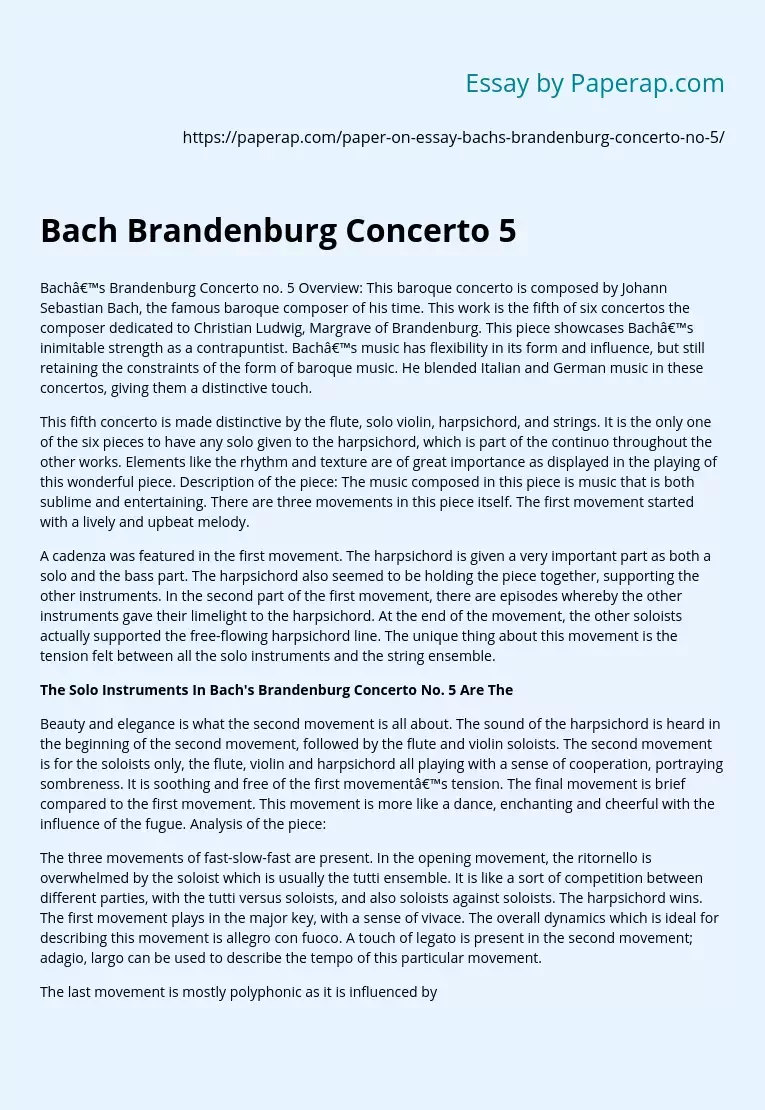Bach Brandenburg Concerto 5
Bach’s Brandenburg Concerto no. 5 Overview: This baroque concerto is composed by Johann Sebastian Bach, the famous baroque composer of his time. This work is the fifth of six concertos the composer dedicated to Christian Ludwig, Margrave of Brandenburg. This piece showcases Bach’s inimitable strength as a contrapuntist. Bach’s music has flexibility in its form and influence, but still retaining the constraints of the form of baroque music. He blended Italian and German music in these concertos, giving them a distinctive touch.
This fifth concerto is made distinctive by the flute, solo violin, harpsichord, and strings. It is the only one of the six pieces to have any solo given to the harpsichord, which is part of the continuo throughout the other works. Elements like the rhythm and texture are of great importance as displayed in the playing of this wonderful piece. Description of the piece: The music composed in this piece is music that is both sublime and entertaining.
There are three movements in this piece itself. The first movement started with a lively and upbeat melody.
A cadenza was featured in the first movement. The harpsichord is given a very important part as both a solo and the bass part. The harpsichord also seemed to be holding the piece together, supporting the other instruments. In the second part of the first movement, there are episodes whereby the other instruments gave their limelight to the harpsichord. At the end of the movement, the other soloists actually supported the free-flowing harpsichord line.
The unique thing about this movement is the tension felt between all the solo instruments and the string ensemble.
The Solo Instruments In Bach’s Brandenburg Concerto No. 5 Are The
Beauty and elegance is what the second movement is all about. The sound of the harpsichord is heard in the beginning of the second movement, followed by the flute and violin soloists. The second movement is for the soloists only, the flute, violin and harpsichord all playing with a sense of cooperation, portraying sombreness. It is soothing and free of the first movement’s tension. The final movement is brief compared to the first movement. This movement is more like a dance, enchanting and cheerful with the influence of the fugue. Analysis of the piece:
The three movements of fast-slow-fast are present. In the opening movement, the ritornello is overwhelmed by the soloist which is usually the tutti ensemble. It is like a sort of competition between different parties, with the tutti versus soloists, and also soloists against soloists. The harpsichord wins. The first movement plays in the major key, with a sense of vivace. The overall dynamics which is ideal for describing this movement is allegro con fuoco. A touch of legato is present in the second movement; adagio, largo can be used to describe the tempo of this particular movement.
The last movement is mostly polyphonic as it is influenced by distinct fugal powers. The subject is introduced and it is then repeated by another instrument. It sounded like a second voice imitating the first voice, accelerando at some point of time. It ended on a major chord. The overall tempo of the final movement is presto. The main instruments playing are the violin, flute and the harpsichord. Rhythm is constant throughout this whole piece, this baroque concerto piece used the quadruple meter. Pitch and texture varies throughout the music piece as well. Reflection of this piece:
The presence of strong contrast and opposition of sonorities made this piece remarkably wonderful. The second movement is slow and restful. This is a prodigious irony, considering how the tensions of the concerto form were exploded in the first with so much zest, in which the restricted form is somehow abandoned at that brief moment. The final movement is my favourite movement as it made me feel like doing a lively dance. It gives a sense of freedom and joviality. Overall, I find this piece of music a rather enchanting piece with a balance of melancholy and exuberance.
Bach Brandenburg Concerto 5. (2019, Dec 05). Retrieved from https://paperap.com/paper-on-essay-bachs-brandenburg-concerto-no-5/

